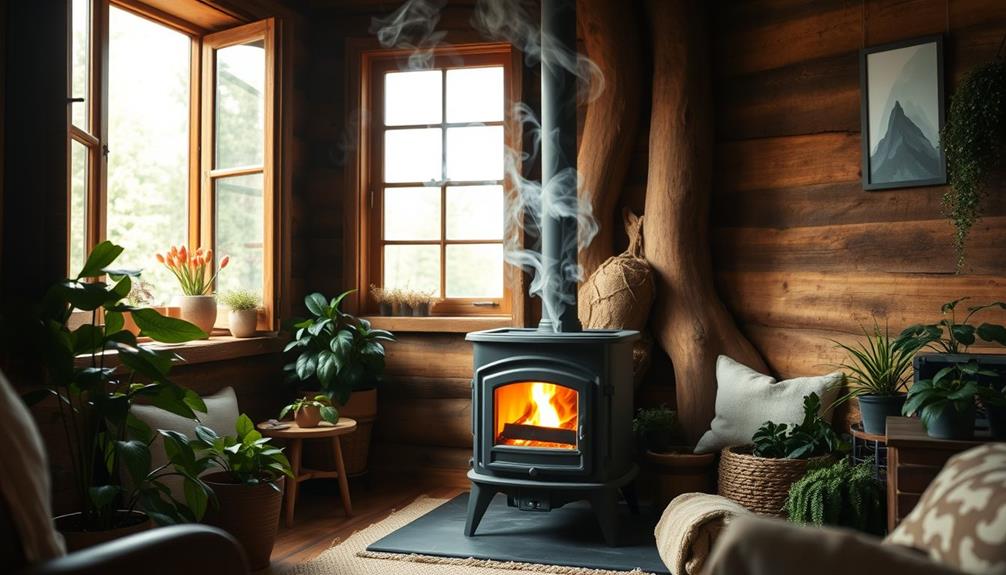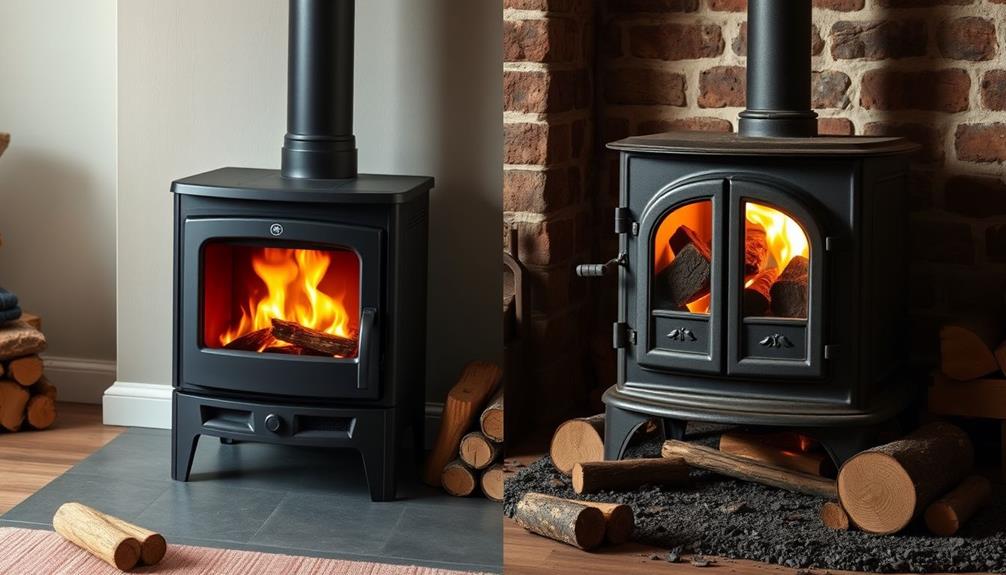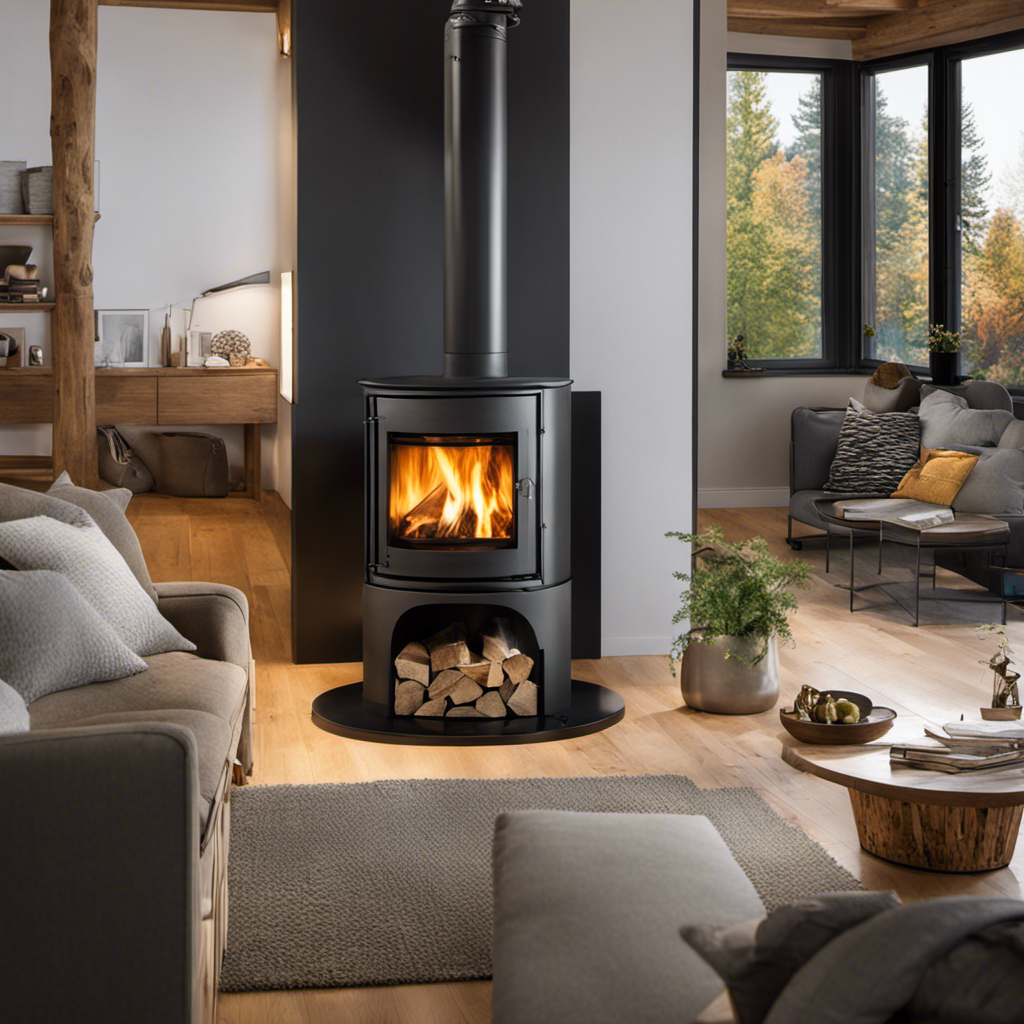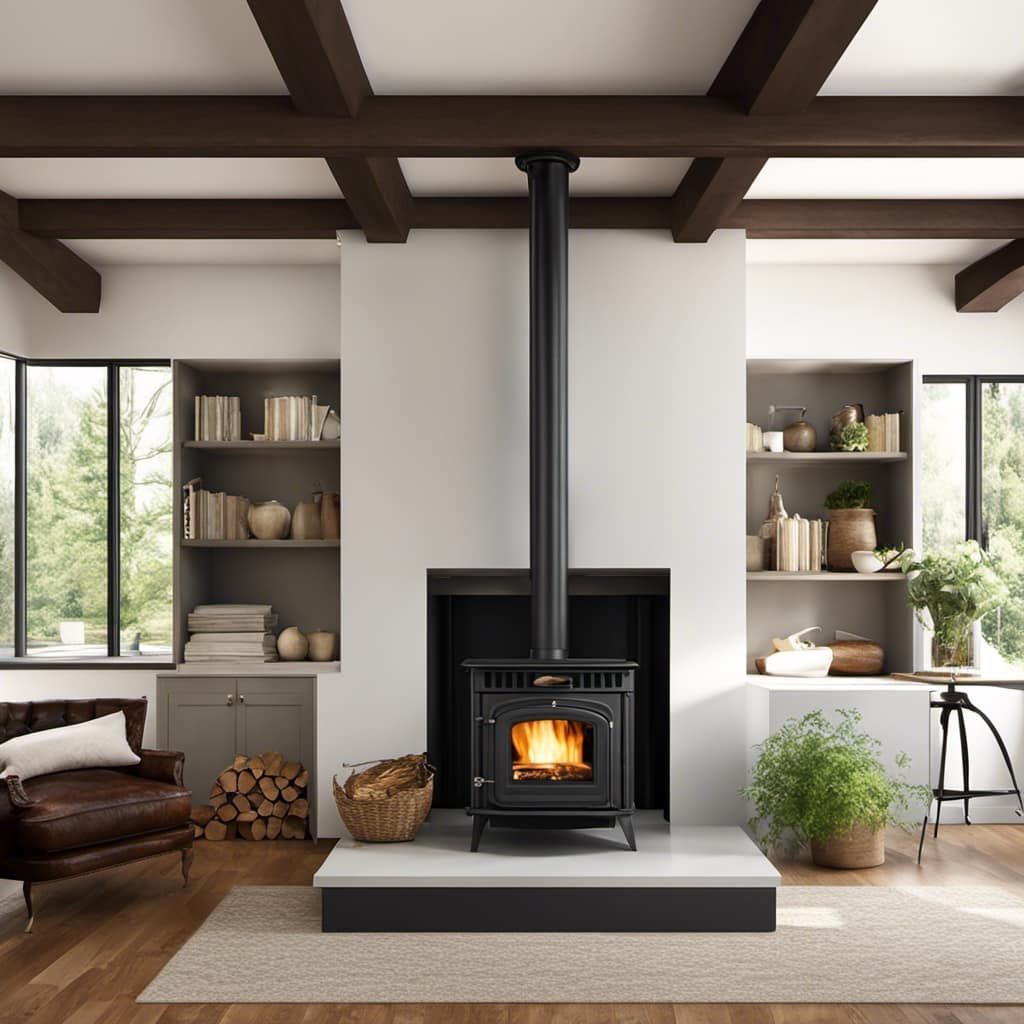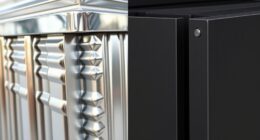To reduce smoke and emissions from your wood stove, start by using dry, seasoned hardwood with a moisture content below 20%. Opt for smaller pieces of wood to enhance combustion efficiency and try the top-down lighting method for hotter burns. Make sure your stove gets adequate air supply by adjusting the vents for peak combustion. Regular maintenance is essential too; clean your stove and chimney monthly to prevent creosote buildup. Finally, avoid burning treated wood or plastics. Getting acquainted with these practices can greatly improve your stove's performance, and there's always more to discover about enhancing your wood stove experience.
Key Takeaways
- Always burn seasoned hardwood with a moisture content below 20% for cleaner combustion and reduced smoke emissions.
- Utilize high-efficiency appliances like the Englander 10-Cpm to minimize particulate matter and improve burning efficiency.
- Implement the top-down lighting method to achieve hotter burns and decrease smoke production by up to 70%.
- Regularly clean and maintain your stove and chimney to prevent creosote buildup and ensure optimal airflow for combustion.
- Avoid burning treated wood or plastics to prevent the release of toxic chemicals and harmful emissions into the air.
Importance of Wood Quality
When it comes to reducing smoke and emissions from your wood stove, the quality of the wood you burn is essential. Burning very dry wood, ideally with less than 20% moisture content, is critical. This greatly minimizes smoke and particulate matter emissions compared to burning green wood, which can contain about 60% water.
Properly seasoned hardwoods like oak or cherry are your best bet; they produce hotter, cleaner fires, enhancing heat output while reducing smoke. Additionally, using proper clogging remedies can also help maintain a clean-burning stove by preventing creosote buildup.
Make sure to store your firewood in a dry, covered area to maintain its dryness. This practice is important for achieving efficient combustion and lowering emissions during burning.
Additionally, opting for smaller wood pieces can make a noticeable difference. They ignite more easily and burn more completely, leading to longer burn times and reduced smoke output.
Effective Burning Techniques
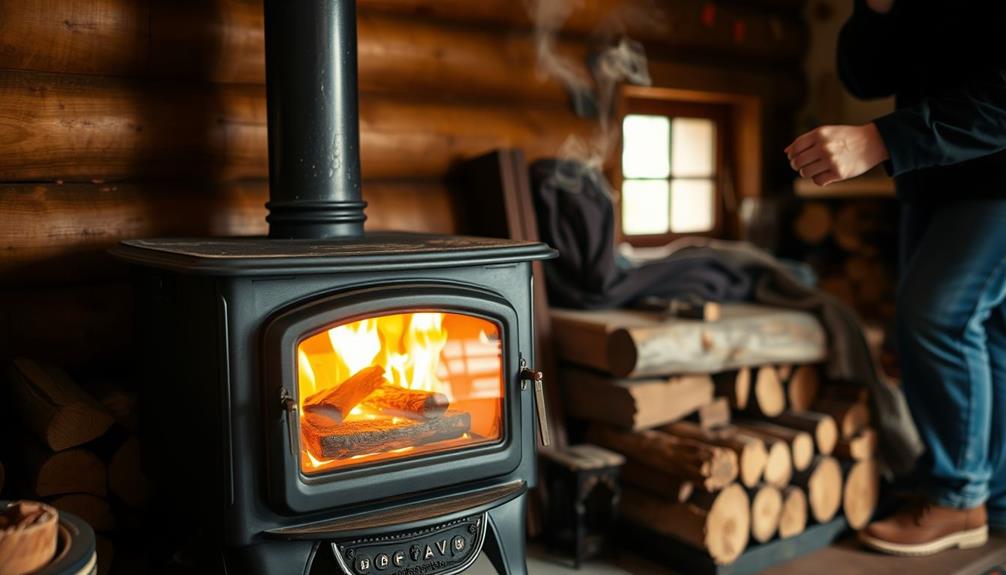
To achieve a cleaner burn and reduce smoke emissions, mastering effective burning techniques is vital.
First, always burn only seasoned or dry hardwood, like oak or cherry, with a moisture content below 20%. This greatly reduces smoke and particulate matter emissions.
Using high-efficiency appliances, such as the Englander 10-Cpm Corn Wood Pellet Stove, can also help in minimizing emissions while guaranteeing consistent heat output.
When starting your fire, try the top-down lighting method. This approach promotes a hotter, cleaner burn, allowing you to reduce smoke by up to 70%.
It's also important to maintain an adequate air supply. Adjust your stove's air vents to achieve ideal combustion, which minimizes visible smoke and promotes efficient burning.
Avoid burning painted, treated wood, or non-wood materials, as these can release toxic chemicals and contribute to higher pollution levels.
Instead, stick to EPA-certified wood for a cleaner burn.
Stove Maintenance Practices

Maintaining your wood stove is as important as using effective burning techniques. Regular stove maintenance not only guarantees safety but also helps reduce indoor air pollution and emissions. Here are some key practices to keep your stove in top shape:
| Maintenance Task | Frequency | Benefits |
|---|---|---|
| Clean and inspect the stove and chimney | Every month | Prevents creosote buildup, enhances air flow |
| Schedule professional cleaning | At least once a year | Reduces fire hazards, improves efficiency |
| Adjust air supply | As needed (during use) | Promotes complete combustion, less smoke |
| Replace/clean filters | As needed | Improves airflow, reduces carbon monoxide risks |
| Use dry wood for burning | Always | Maintains hot fire, reduces particulate emissions |
Environmental Considerations
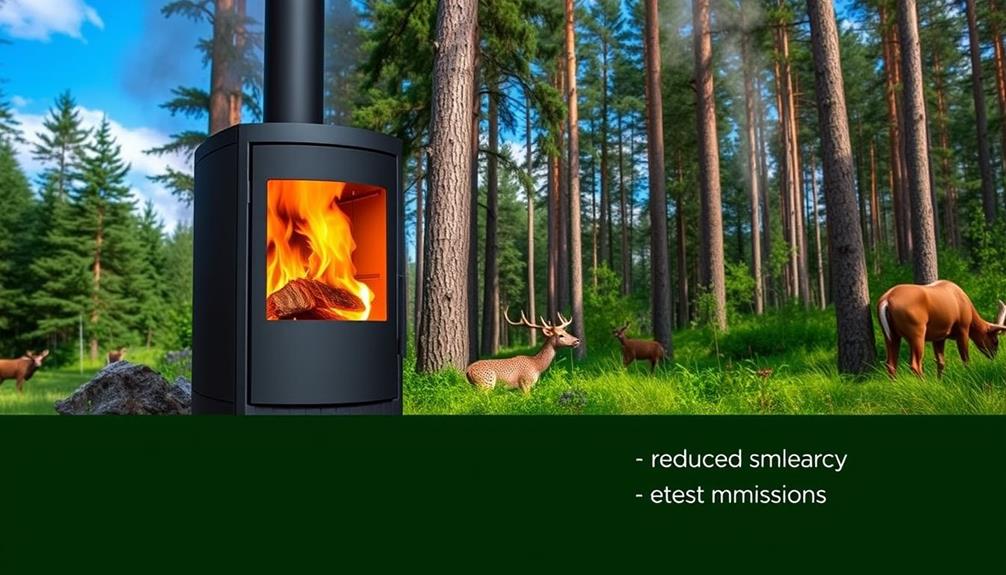
Understanding the environmental impact of wood stoves is vital for anyone looking to minimize their carbon footprint. Wood smoke notably contributes to air pollution from wood, with wood stoves emitting up to 30 grams of particulate matter (PM) per hour.
To improve the effectiveness of your wood stove while reducing emissions, consider incorporating hydration strategies for maintaining ideal combustion conditions; this can lower PM emissions by up to 70%. You can reduce these emissions by adopting efficient wood burning practices, such as using dry, seasoned wood and maintaining ideal combustion conditions, which can lower PM emissions by up to 70%.
It's important to avoid burning inappropriate materials like treated wood or plastics, as these release toxic chemicals that worsen air quality and pose health risks.
Instead, consider investing in modern EcoDesign wood stoves. These stoves are engineered to produce fewer pollutants compared to older models and conventional heating methods, making them a more environmentally friendly choice.
Additionally, focus on sustainable sourcing and proper forest management practices. This approach guarantees that burning wood remains a renewable energy source, helping to balance carbon emissions throughout the lifecycle of trees.
Community Engagement and Education

Community engagement and education play an essential role in reducing smoke and emissions from wood stoves. By participating in community education programs, you can learn about the importance of using seasoned wood and maintaining your stove. This knowledge greatly impacts smoke emissions and improves air quality.
Engaging in local workshops offers hands-on training on best practices for wood burning. You'll gain insights into the proper operation and maintenance of woodburning stoves, which helps minimize particulate matter emissions. Collaborative efforts with local environmental health offices can also raise awareness about air quality regulations and the health impacts of wood smoke.
Neighborhood initiatives promoting EPA-certified wood stoves can lead to a collective reduction in emissions, as these stoves can cut particulate emissions by up to 70%. Community discussions about wood burning also help alleviate disputes over smoke drifting into neighboring properties, fostering understanding and cooperation among residents.
| Initiative Type | Benefits |
|---|---|
| Community Education Programs | Inform residents about seasoned wood usage |
| Local Workshops | Hands-on training for stove maintenance |
| Neighborhood Initiatives | Promotion of EPA-certified stoves |
Frequently Asked Questions
How Do I Reduce the Emissions on My Wood Stove?
To reduce emissions on your wood stove, use seasoned wood, maintain good airflow for hotter fires, avoid burning treated materials, clean your stove regularly, and consider upgrading to an EPA-certified model for greater efficiency.
How to Reduce Pollution From Wood Burning Stoves?
Imagine a cozy fire, its flames dancing gracefully. To reduce pollution from wood-burning stoves, use seasoned hardwood, maintain airflow, avoid treated wood, clean regularly, and consider upgrading to an EPA-certified model for cleaner burning.
How to Prevent Smoke From a Wood Burning Stove?
To prevent smoke from your wood burning stove, use dry hardwood, maintain a hot fire, and avoid burning treated materials. Regularly clean your stove and monitor your flames for better combustion and less smoke.
How Can I Make My Wood Burning Stove More Efficient?
To turn your wood stove into a roaring furnace of efficiency, use seasoned hardwood, guarantee proper airflow, clean it regularly, and consider an upgrade. You'll savor warmth while cutting waste and maximizing your fire's potential.
Conclusion
By prioritizing wood quality, employing effective burning techniques, and maintaining your stove, you can greatly reduce smoke and emissions. Think of each log you burn as a brushstroke on the canvas of our environment—every choice matters. Engaging your community in these practices can spark a collective movement towards cleaner air. As you embrace these strategies, remember that you're not just kindling a fire; you're nurturing the very air we breathe, echoing the age-old wisdom of stewardship.

